Twice the cruising pleasure for half the cost? Really?
What am I talking about? How can I spend an additional half the purchase price of a used boat and expect to double my cruising pleasure? Why not take that money and buy a bigger, better, or newer boat to begin with? Valid questions for sure; now hear me out.
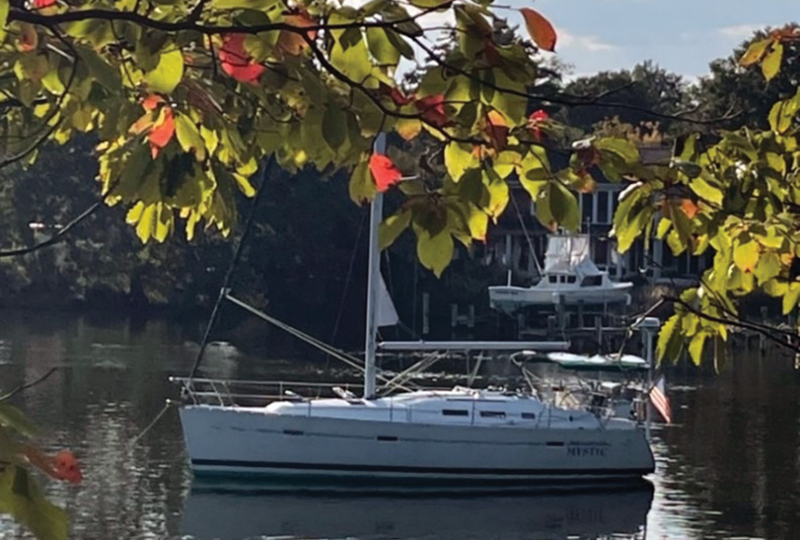
Mystic is a 2005 Beneteau 373 that I purchased in the fall of 2020 that has the space and cruising comfort we had been seeking as long as we remained tethered to shore power, with heating and air conditioning, refrigeration, microwave, and unlimited hot water. Those advantages were diminished at anchor since Mystic only had a single 160Ahr house battery, no inverter, and not even an anchor washer. Don’t get me wrong: I grew up in the Annapolis area sailing and cruising, using much more primitive means.
I knew an inverter, a second house battery, and anchor washer were minimum necessities. These were hardly budget busters. I also installed four 175-watt flexible solar panels on a large Bimini top. With those upgrades, I was now ready for the 2021 cruising season to begin. I even purchased an electric outboard with a Lithium Iron Phosphate (LiFePO4) battery for our inflatable dinghy.
Here comes the sun
Those solar panels are going to provide all the capacity I need, right? That includes full-time refrigeration and auxiliary needs like the microwave, cabin lights, instruments, charging the dinghy battery, and even domestic hot water. However, after a few cruises that spring, it became apparent that the battery storage was inadequate. The engine alternator proved to be anemic and appeared to be charging intermittently. Cloudy days were especially difficult given my limited storage capacity.
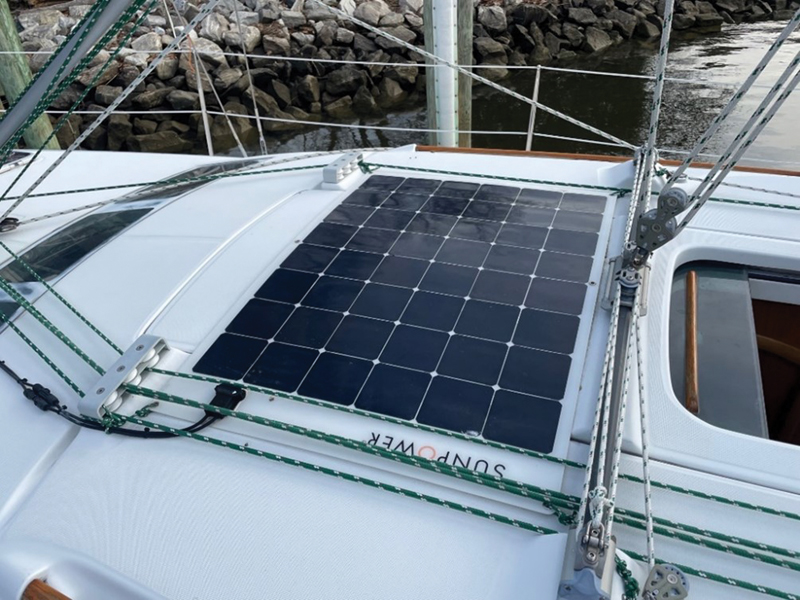
I was satisfied with the solar panel system I purchased from Sun Powered Yachts. Lyall Burgess provided great advice. The systems included cabling, connectors, controllers, and circuit breakers plus guidance for the DIY installer. I later contacted Lyall regarding storage capacity, and he confirmed my suspicion that LiFePO4 batteries were game changers. I replaced the existing lead acid batteries with two 200Ahr Dakota Lithium batteries, which equaled four times the useable storage capacity at half the weight. No more storage capacity issues. That would complete my system upgrade.
That is, until Lyall mentioned 12-volt heating and air conditioning, and I was hooked. Mabru Power Systems offers a line of 12-volt HVAC units, the smallest of which (at 4200 BTU) I considered suitable for the aft cabin, especially given the lack of natural ventilation and engine compartment heat associated with that cabin. Clearly, I have now entered the realm of higher cost upgrades. Am I now going to tax the available storage and solar panel capacity? Probably.
We had offered the forward cabin to our guests realizing that the forward cabin would have better ventilation and be cooler. Now we have given ourselves the air-conditioned suite. How rude! You can see where this is going. Towards the end of the 2021 cruising season, we replaced the 120-volt shore powered main cabin unit with a smaller 12-volt 7000 BTU unit. Duct work from this unit also serves the forward cabin. A third 200Ahr battery would be necessary. There was no room for it back aft, but fortunately, there was sufficient space for it under the forward berth.
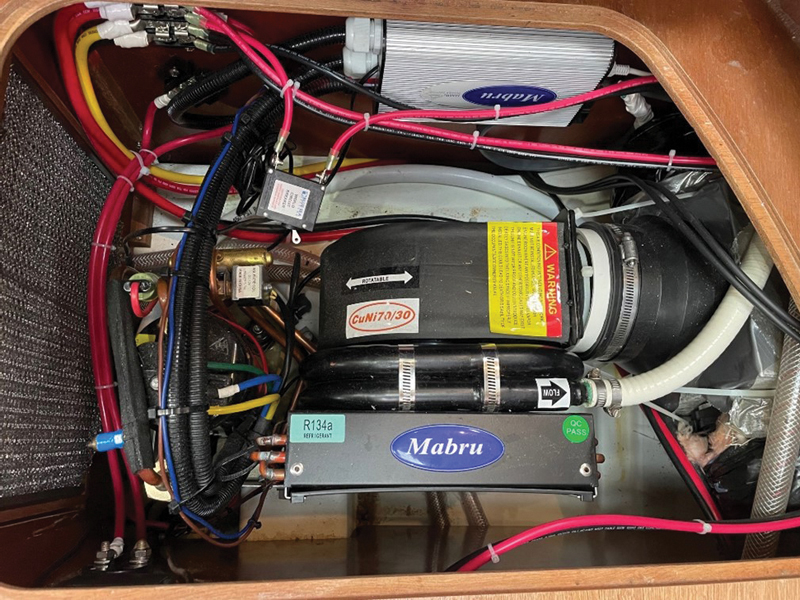
Shopping at the Sailboat Show
We knew we needed greater alternator capacity and a LiFePO4 compatible shore power battery charger. The Annapolis Sailboat Show gave us the opportunity to explore various products and hopefully install them prior to our last overnight cruise of the season. We selected a Balmar 120-amp alternator and a Sterling Power 40-amp battery charger. Our last cruise was in mid-November in Hopkins Creek off the Severn River. It was cold, so we got a good taste of the adequacy of the systems installed. The capacity of the two heat pumps was sufficient, but the storage capacity was marginal. Also, the charging capacity of the new high output alternator was disappointing. I had yet to install an alternator amp meter, so the charging problem was not immediately apparent. I knew that I needed more charging and storage capacity and had time over the winter to complete those tasks.
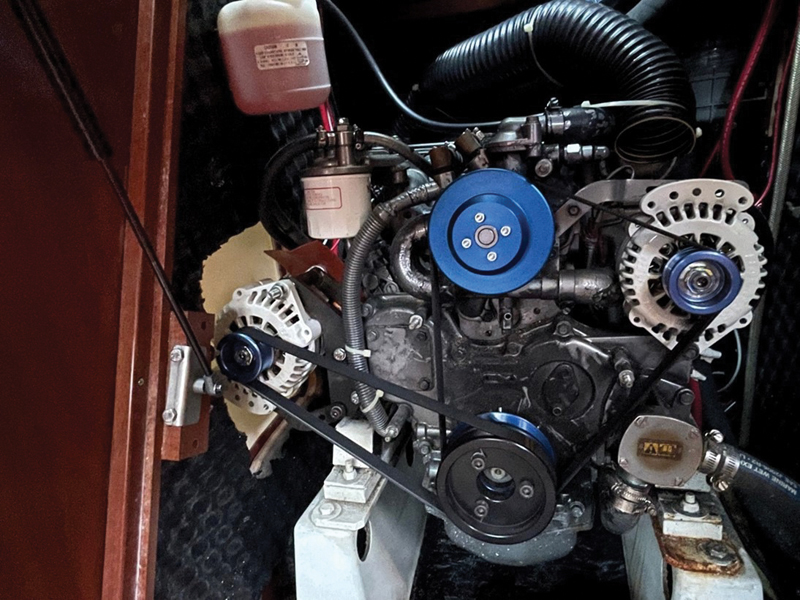
What remained was to add a fourth 200Ahr LiFePO4 battery, alternator amp meters, battery status indicators, a second high output alternator, and three more solar panels. Lyall had also put a bug in my ear during the previous season, so I added a Schenker Zen 30 energy recovery water maker, capable of making eight gallons of water per hour with an energy consumption of 110 watts.
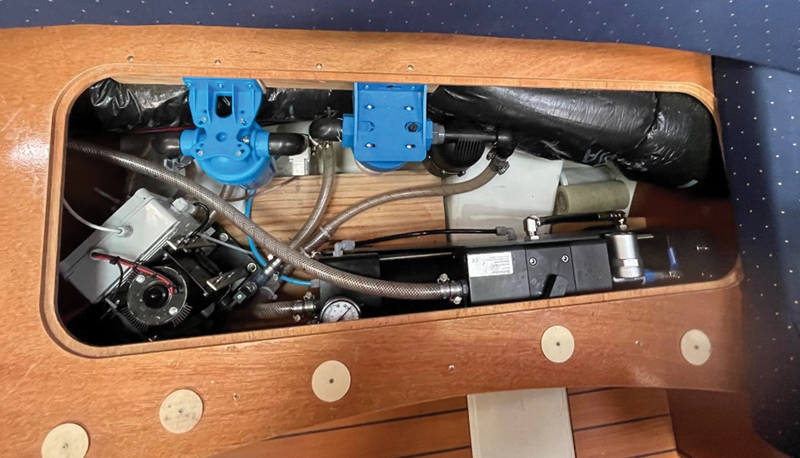
Oh, and one more thing: West Marine had a buy one get one free deal on electric primary winches that I could not resist. Now that I had the means to power a small city, it made perfect sense to add electric winches.
Fortunately, there was room for two batteries beneath the forward berth. The charging issue with the high-capacity alternator was linked to its proximity to the engine heat exchanger resulting in reduced charging as the engine heated up. This problem was alleviated by adding an engine compartment exhaust blower, thus reducing the engine compartment heat. After a full season of cruising in 2022, I can confidently say the installed systems are up to the task.
Weight and maintenance
But what about my claim of doubling my cruising pleasure? Let’s start with the added weight of all these systems. The batteries weigh less, although slightly more when you consider four batteries versus two. The two additional 12-volt AC units are no heavier than the original 120-volt AC unit they replaced. The solar panels, inverter, watermaker, extra alternator, cabling, and accessories certainly add weight, but add less than the 45 gallons of water no longer stored in the aft water tank. The 55-gallon forward water tank is more than sufficient since that tank can be topped off daily with the flick of a switch.
How about system maintenance? So far, the batteries have been maintenance-free, and the solar panels have been maintenance free. The inverter is maintenance free. The AC units require periodic water intake filter cleaning and air filter cleaning. The watermaker has a rinsing cycle that maintains fresh water in the system between uses. Long-term maintenance requires that it be operated once a week, that the intake filter be cleaned periodically, and an intermediate filter be replaced annually. The cabin heating system provides freeze protection and moisture reduction eliminating winterizing/de-winterizing as well as mildew and corrosion abatement.
Cruising in comfort
Okay, so weight and maintenance are sum zero. Let’s talk benefits. I sail year-round since winterization is now eliminated. The ideal cruising months of May, June, September, and October on the Chesapeake are bracketed by four months that are often too hot or too cold for cruising comfort. Uninterrupted heating or cooling is available for 12-15 hours between recharge cycles. I can cruise in comfort for eight months of the year. To supplement solar charging, the dual high output alternators provide 150 amperes at a throttle setting slightly above idle with a fuel consumption of around 0.20-0.25 gallon/hour. Finally, the electric winches provide the solo sailor unlimited ability to tack upwind in close quarters or in a narrow body of water.
These upgrade projects have been educational and rewarding for me. I hope that by sharing this information, it may help others pursue aspects that appeal to their particular interests.
by Keith Donald




